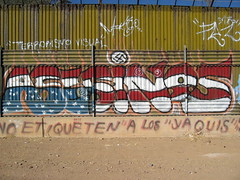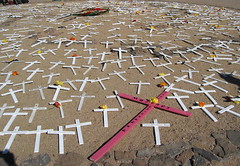|
|
mexico
Los Magonistas
Muy interesante. I just found out tonight about a movement or group of communities in Oaxaca called Consejo Indigena Popular de Oaxaca "Ricardo Flores Magon". They're similar to the Zapatistas, I'm told, except they never took up arms, but apparently they've been organizing autonomous communities and using non-violent resistance to the military and the government. El Sup just met with them last week as part of the Other Campaign tour.
A woman here in Tucson who I know is working on doing english subtitles for 3 films about this group. She wants to have a fundraising screening in early March. We're helping her with this stuff at Pan Left. The longest of these films is called Sembrando Esperanzas - "Sowing Hope."
It's exciting to learn about other popular rebellions going on in Mexico, influenced by the EZLN but also doing things their own way. CIPO, or the Magonistas, seem to be more overtly anarchist than the Zapatistas, and less interested in being part of a Mexican nation-state.
The Border and NAFTA
The Washington Post ran a nice little op-ed piece that is a good summary of the connection between illegal immigration and NAFTA. A connection our legislators are refusing to make.
(via Jos
Nogales
 Tuesday I went to Nogales, just across the border and just an hour's drive south of Tucson. I went with a friend, Jonathan, who works for a cool organization called Borderlinks. He was going there for work, and I tagged along, since I'd never been there before. It was a great trip, I learned a lot and met some of the people Borderlinks works with there. I took a bunch of pretty interesting photos. The second Mexican/U.S. border town I've been to, It was interesting comparing Nogales to Juarez/El Paso. Nogales is definitely smaller (around 280,000 compared to Juarez's 1.5 million), and Nogales seems a little more "Mexican" - less "gringoized," though it still has that unique borderland feel that is a mix of both cultures. Nogales, though less contaminated than Juarez with gringo brandnames and businesses, seems to have grown in an even more disorganized way, being really just a long thin strip of buildings lining the highway south toward Hermasillo, following the maquiladoras. And it has no z
Tuesday I went to Nogales, just across the border and just an hour's drive south of Tucson. I went with a friend, Jonathan, who works for a cool organization called Borderlinks. He was going there for work, and I tagged along, since I'd never been there before. It was a great trip, I learned a lot and met some of the people Borderlinks works with there. I took a bunch of pretty interesting photos. The second Mexican/U.S. border town I've been to, It was interesting comparing Nogales to Juarez/El Paso. Nogales is definitely smaller (around 280,000 compared to Juarez's 1.5 million), and Nogales seems a little more "Mexican" - less "gringoized," though it still has that unique borderland feel that is a mix of both cultures. Nogales, though less contaminated than Juarez with gringo brandnames and businesses, seems to have grown in an even more disorganized way, being really just a long thin strip of buildings lining the highway south toward Hermasillo, following the maquiladoras. And it has no z
Border Deaths
 One of the big "issues" here in Tucson is of course related to the border, and the fact that many people who are prevented from coming to the U.S. legally look for other ways. Immigrants have crossed the border from Mexico illegally for a long time, but in the last several years border security has been tightened in all the places where it's easy to cross: the big cities and the more hospitable areas - leaving only the dangerous and hostile desert country. The U.S. government considers this a deterrent, but people still keep coming, and now are dying in record numbers as they try to cross the desert.
One of the big "issues" here in Tucson is of course related to the border, and the fact that many people who are prevented from coming to the U.S. legally look for other ways. Immigrants have crossed the border from Mexico illegally for a long time, but in the last several years border security has been tightened in all the places where it's easy to cross: the big cities and the more hospitable areas - leaving only the dangerous and hostile desert country. The U.S. government considers this a deterrent, but people still keep coming, and now are dying in record numbers as they try to cross the desert.
In Tucson there are many who oppose the government border policies, and many activists go out in the desert and leave water and food, or look for migrants in order to help them. This past summer, the situation came to a new level when 2 activists found some critically sick migrants and knew they had to get to a hospital. While driving them to a hospital in Tucson they were stopped by the Border Patrol and arrested. They're being charged with with one felony count of transportation of an undocumented person and one felony count of obstruction of justice., and the trial is set for December 20, I think.
Every year activists and community members have an 8-mile walk, carrying little white crosses, in commemoration of all those who have died. I went this past weekend and it was really amazing and moving.
Here's a short, completely unedited video I shot on my little still cam of local activist folksinger Ted Warmbrand, singing a song about the situation called "Who's the Criminal Here?"
Zapatistas, Better Off, or Not?
When I was in Chiapas this summer, there was one thing I kept wondering: are the Zapatista people better off for being Zapatistas, or not? An article in today's New York Times addresses just that, though I'm taking it with a grain of salt, like anything in the media.
The conclusion the reporter makes is that things aren't much different between Zapatista and government supporters, and in fact some have left the Zapatista ranks, lured away by government aid programs. I saw myself that life is still very hard for the indigenous people in Zapatista territory. However, it also seemed like there was lots of progress, especially in terms of health care that the Zapatistas are making available through clinics and "microclinics." And besides that, I am reminded of something mentioned by Subcommandante Marcos, who freely states in his recent writings that, yes, things are still very dismal for the Zapatistas, but there is one important difference: now they have hope, and pride. This is something not quantifiable and hence not as easy for a publication like the New York Times to report on. It's not as easy to measure as the thousands of pesos being poured into Chiapas by the federal government or the numbers of troops still occupying military bases there.
Gringoton
While in Chiapas I learned of a film called "Grington" (or "Gringothon" in english) by an expatriate from the U.S. living in Mexico, Greg Berger. I recently found it available for download from the excellent Salon Chingon site (which is connected with Narco News), and last night I finally watched it. It's really great and really funny. The film is all about Greg feeling helpless as a gringo living in Mexico during the start of the Iraq War, and so he decides to start a campaign to raise money to fund an insurrection in the U.S. to oust George Bush. He goes around D.F. dressed as a tourist, speaking purposely really badly-pronounced spanish, and trying to get people to donate to the cause. I recommend downloading and watching it, and if you ever have a chance to see any of his other work, do so - I obtained some DVDs while in Mexico of a few of his other pieces, and they're really excellent. He has a website at gringoyo.com.
Fox a Complete Failure
In the wake of the PRI's victory last week in the election of governor for el Estado de Mexico, the country's most populous state, The Council on Hemispheric Affairs gives us this detailed account of just how terrible Vincente Fox has been as president of Mexico.
Fllanos
 I keep meaning to blog about this. When I was in Chihuahua City a few weeks ago, I saw some stickers and wheatpasted flyers that indicated there was some political/artistic/countercultural undercurrent going on there. Which I was surprised about because it seems like a pretty sterile city, all about business and state government and very little culture, except for lots of cowboy boot stores. Anyway one of the most interesting things turned out to be a poster with the url fllanos.com on it. It turns out to be the well-designed site of an interesting video artist from Mexico City named Fernando Llanos. No idea why his url would be plastered on walls in Chihuahua City, but I'm glad they were.
I keep meaning to blog about this. When I was in Chihuahua City a few weeks ago, I saw some stickers and wheatpasted flyers that indicated there was some political/artistic/countercultural undercurrent going on there. Which I was surprised about because it seems like a pretty sterile city, all about business and state government and very little culture, except for lots of cowboy boot stores. Anyway one of the most interesting things turned out to be a poster with the url fllanos.com on it. It turns out to be the well-designed site of an interesting video artist from Mexico City named Fernando Llanos. No idea why his url would be plastered on walls in Chihuahua City, but I'm glad they were.
He has a mailing list that he uses to send out little videos he's done, and I found it interesting to see that he sends to the list every Tuesday because that's the day he can't drive in Mexico City. In D.F. to cut down on pollution everyone has one day a week that they can't drive their car, depending on your license plate number. I often wondered about that when I was there, if many of the people I saw enjoying leisure time were not at work because it was their own "car free day."

